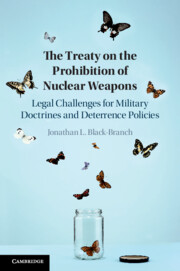 The Treaty on the Prohibition of Nuclear Weapons
The Treaty on the Prohibition of Nuclear Weapons Book contents
- The Treaty on the Prohibition of Nuclear Weapons
- Reviews
- The Treaty on the Prohibition of Nuclear Weapons
- Copyright page
- Contents
- Foreword
- Preface
- Acknowledgments
- Abbreviations
- 1 Changing the Status Quo in Nuclear Arms Control Law: The Treaty on the Prohibition of Nuclear Weapons 2017
- 2 Adopting the Treaty on the Prohibition of Nuclear Weapons 2017: A New Dawn, a New Deal, a New Direction in Nuclear Disarmament Law?
- 3 Humanitarian Nuclear Disarmament: Challenging the Status Quo through New Approaches to Legal Process, Purpose and Provisions
- 4 Legal Congruence with Existing Treaty Obligations: Toward Complementary or Competing Interests?
- 5 Customary International Law, Opinio Juris and State Practice Regarding the Treaty on the Prohibition of Nuclear Weapons 2017: Toward Universality?
- 6 Treaty Safeguards, Verification and Implementation: A Simple-Ban Approach and a Need for Oversight
- 7 Nuclear Deterrence Policies and the Prohibition Treaty: Disarmament Considerations
- 8 Nuclear Defense Doctrines: Disarmament and Emerging Humanitarian Concerns
- 9 Competition, Fragmentation and Polarization: A Bifurcated International Legal Infrastructure Regarding the Nuclear Architecture and Regulation?
- 10 Stigmatization-Action and Changing Global Perceptions to Delegitimize and Eliminate Nuclear Weapons
- 11 Toward Neo-Universalism: Toward a New Reality in International Law?
- 12 Obligations Erga Omnes: The Missing Link for Nuclear Nonproliferation and Disarmament Compliance
- 13 The Treaty on the Prohibition of Nuclear Weapons within the Nuclear Nonproliferation and Security Architecture in International Law: From Grand Bargain to Grand Challenges with the Right to Nuclear Peace and Freedom from Nuclear Fear: Summaries and Conclusions
- Index
4 - Legal Congruence with Existing Treaty Obligations: Toward Complementary or Competing Interests?
Published online by Cambridge University Press: 17 April 2021
- The Treaty on the Prohibition of Nuclear Weapons
- Reviews
- The Treaty on the Prohibition of Nuclear Weapons
- Copyright page
- Contents
- Foreword
- Preface
- Acknowledgments
- Abbreviations
- 1 Changing the Status Quo in Nuclear Arms Control Law: The Treaty on the Prohibition of Nuclear Weapons 2017
- 2 Adopting the Treaty on the Prohibition of Nuclear Weapons 2017: A New Dawn, a New Deal, a New Direction in Nuclear Disarmament Law?
- 3 Humanitarian Nuclear Disarmament: Challenging the Status Quo through New Approaches to Legal Process, Purpose and Provisions
- 4 Legal Congruence with Existing Treaty Obligations: Toward Complementary or Competing Interests?
- 5 Customary International Law, Opinio Juris and State Practice Regarding the Treaty on the Prohibition of Nuclear Weapons 2017: Toward Universality?
- 6 Treaty Safeguards, Verification and Implementation: A Simple-Ban Approach and a Need for Oversight
- 7 Nuclear Deterrence Policies and the Prohibition Treaty: Disarmament Considerations
- 8 Nuclear Defense Doctrines: Disarmament and Emerging Humanitarian Concerns
- 9 Competition, Fragmentation and Polarization: A Bifurcated International Legal Infrastructure Regarding the Nuclear Architecture and Regulation?
- 10 Stigmatization-Action and Changing Global Perceptions to Delegitimize and Eliminate Nuclear Weapons
- 11 Toward Neo-Universalism: Toward a New Reality in International Law?
- 12 Obligations Erga Omnes: The Missing Link for Nuclear Nonproliferation and Disarmament Compliance
- 13 The Treaty on the Prohibition of Nuclear Weapons within the Nuclear Nonproliferation and Security Architecture in International Law: From Grand Bargain to Grand Challenges with the Right to Nuclear Peace and Freedom from Nuclear Fear: Summaries and Conclusions
- Index
Summary
The text of the TPNW was agreed during a relatively short negotiation period. It includes comprehensive prohibitions regarding participation in any nuclear weapon activities, including undertakings not to develop, test, produce, acquire, possess, stockpile, use or threaten to use nuclear weapons. The Treaty prohibits the deployment of nuclear weapons on national territory and requires states parties to prevent and suppress any prohibited activity by persons within or on their territory or under their jurisdiction or control.
Keywords
- Type
- Chapter
- Information
- The Treaty on the Prohibition of Nuclear WeaponsLegal Challenges for Military Doctrines and Deterrence Policies, pp. 74 - 104Publisher: Cambridge University PressPrint publication year: 2021
